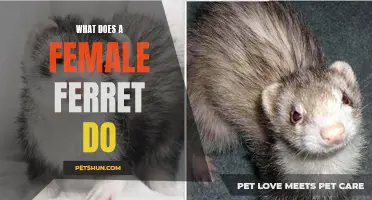
The black-footed ferret, an adorable and critically endangered species native to North America, is a fascinating creature with a remarkable ability to adapt and survive. However, one question that has puzzled researchers and wildlife conservationists for years is whether or not these ferrets can interbreed with other closely related species. Join us as we dive into the world of black-footed ferrets and explore the possibilities of genetic blending.
| Characteristics | Values |
|---|---|
| Conservation Status | Endangered |
| Scientific Name | Mustela nigripes |
| Family | Mustelidae |
| Range | North America |
| Habitat | Grasslands and prairies |
| Diet | Mainly prairie dogs |
| Size | Length: 18-24 inches |
| Weight | 1-3.5 pounds |
| Lifespan | 3-4 years |
| Social Structure | Solitary or live in small groups |
| Reproduction | Mating in spring and giving birth in late spring or early summer |
| Main Threats | Habitat loss and disease |
| Interbreeding Possibility | Can interbreed with other species of ferrets if closely related |
What You'll Learn

Can black footed ferrets interbreed?
Black-footed ferrets (Mustela nigripes) are a charismatic species that were once on the brink of extinction. Thanks to successful conservation efforts, their population has slowly increased. However, the question of whether black-footed ferrets can interbreed remains. In this article, we will explore the concept of interbreeding among related species, genetic compatibility of black-footed ferrets, and the challenges and potential risks associated with interbreeding them.
Black-Footed Ferrets: A Brief Introduction
Black-footed ferrets are small, carnivorous mammals native to North America. They are known for their distinctive black fur on their feet and mask-like markings on their faces. Historically, they inhabited the Great Plains and relied heavily on prairie dogs for food and shelter. Due to habitat loss, diseases, and the decline of prairie dog populations, black-footed ferret numbers plummeted, leading to their near-extinction.
Interbreeding Among Related Species
Interbreeding, or hybridization, refers to the mating or reproduction between individuals of different but closely related species. This phenomenon occurs when there is genetic compatibility between two species, allowing them to produce viable offspring. In some cases, closely related species may interbreed naturally, while in others, hybridization may occur as a result of human interactions or human intervention.
Genetic Compatibility of Black-Footed Ferrets
Black-footed ferrets belong to the Mustelid family, which includes species like weasels, minks, and otters. While these species are taxonomically related, interbreeding between them is rare. Black-footed ferrets have evolved to be specialized predators of prairie dogs, with distinct genetic adaptations that help them thrive in this unique ecological niche.
Despite their genetic compatibility with other Mustelid species, black-footed ferrets rarely interbreed in the wild. This may be due to differences in mating behaviors, reproductive cycles, and ecological preferences. Furthermore, black-footed ferrets face considerable conservation challenges and are managed as a distinct species with specific breeding programs to preserve their genetic integrity.
Challenges and Potential Risks of Interbreeding Black-Footed Ferrets
While interbreeding may seem like a potential solution to increase genetic diversity and boost population numbers, there are several challenges and potential risks associated with interbreeding black-footed ferrets:
A. Genetic Dilution: Interbreeding with closely related species may dilute the unique genetic traits and adaptations that enable black-footed ferrets to survive in their prairie dog-dependent ecosystem.
B. Disease Transmission: Introducing genetic material from other species may increase the risk of disease transmission, as some diseases may be specific to certain species.
C. Ecological Adaptations: Black-footed ferrets have evolved to thrive in prairie dog burrows, a behavior not necessarily shared by other Mustelid species. Interbreeding may disrupt this ecological adaptation and impact their survival in the wild.
D. Conservation Management: Black-footed ferret recovery programs are carefully managed to maintain the genetic integrity of the species. Introducing genetic material from other species would complicate conservation efforts and make it challenging to monitor and sustain populations effectively.
While black-footed ferrets are taxonomically related to other Mustelid species, interbreeding between them is rare. The genetic compatibility, ecological adaptations, and conservation management practices all play a role in maintaining the genetic integrity of black-footed ferrets. While interbreeding may seem like a potential solution to boost population numbers, it comes with significant challenges and potential risks. Conservation efforts should focus on preserving and enhancing their natural habitat, protecting prairie dog populations, and maintaining genetic diversity within the black-footed ferret species.
The Relation between Sables and Ferrets Explained
You may want to see also
Frequently asked questions
No, black footed ferrets can only interbreed with other black footed ferrets. They cannot successfully reproduce with other species of ferrets or animals.
No, the main threat to black footed ferrets' population decline is habitat loss and disease, not interbreeding. In fact, efforts are being made to prevent interbreeding to maintain the genetic purity of the species.
No, domestic ferrets and black footed ferrets are different species and cannot interbreed. Domestic ferrets are descended from the European polecat and have been selectively bred for specific traits, making them genetically distinct from black footed ferrets.
Interbreeding can lead to a loss of genetic diversity, which can impact a species' ability to adapt to changing environments and increase their vulnerability to diseases and other threats. To ensure the long-term survival of black footed ferrets, preserving their distinct genetic makeup is important.
Yes, conservation efforts include captive breeding programs and strict management of reintroduced populations to minimize interbreeding with other species. Genetic testing is often conducted to ensure all individuals in the breeding program are purebred black footed ferrets.







